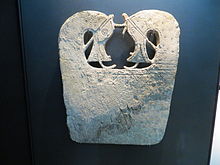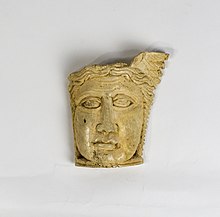
Ivory is a hard, white material from the tusks and teeth of animals, that consists mainly of dentine, one of the physical structures of teeth and tusks. The chemical structure of the teeth and tusks of mammals is the same, regardless of the species of origin, but ivory contains structures of mineralised collagen. The trade in certain teeth and tusks other than elephant is well established and widespread; therefore, "ivory" can correctly be used to describe any mammalian teeth or tusks of commercial interest which are large enough to be carved or scrimshawed.

In archaeology, a hammerstone is a hard cobble used to strike off lithic flakes from a lump of tool stone during the process of lithic reduction. The hammerstone is a rather universal stone tool which appeared early in most regions of the world including Europe, India and North America. This technology was of major importance to prehistoric cultures before the age of metalworking.

A netsuke is a miniature sculpture, originating in 17th century Japan. Initially a simply-carved button fastener on the cords of an inrō box, netsuke later developed into ornately sculpted objects of craftsmanship.
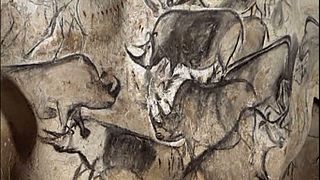
In the history of art, prehistoric art is all art produced in preliterate, prehistorical cultures beginning somewhere in very late geological history, and generally continuing until that culture either develops writing or other methods of record-keeping, or makes significant contact with another culture that has, and that makes some record of major historical events. At this point ancient art begins, for the older literate cultures. The end-date for what is covered by the term thus varies greatly between different parts of the world.

Relief is a sculptural method in which the sculpted pieces remain attached to a solid background of the same material. The term relief is from the Latin verb relevo, to raise. To create a sculpture in relief is to give the impression that the sculpted material has been raised above the background plane. When a relief is carved into a flat surface of stone or wood, the field is actually lowered, leaving the unsculpted areas seeming higher. The approach requires a lot of chiselling away of the background, which takes a long time. On the other hand, a relief saves forming the rear of a subject, and is less fragile and more securely fixed than a sculpture in the round, especially one of a standing figure where the ankles are a potential weak point, particularly in stone. In other materials such as metal, clay, plaster stucco, ceramics or papier-mâché the form can be simply added to or raised up from the background. Monumental bronze reliefs are made by casting.
Portable art refers to the small examples of Prehistoric art that could be carried from place to place, which is especially characteristic of the Art of the Upper Palaeolithic and Mesolithic eras. Often made of ivory, bone, antlers or stone, these pieces have been found in South Africa all the way up to Eurasia. It is one of the two main categories of Prehistoric art, the other being the immobile Parietal art, effectively synonymous with rock art.

Scrimshaw is scrollwork, engravings, and carvings done in bone or ivory. Typically it refers to the artwork created by whalers, engraved on the byproducts of whales, such as bones or cartilage. It is most commonly made out of the bones and teeth of sperm whales, the baleen of other whales, and the tusks of walruses.

A casket is a decorative box or container that is usually smaller than a chest and is typically decorated. In recent centuries they are often used as boxes for jewelry, but in earlier periods they were also used for keeping important documents and many other purposes. Many ancient caskets are reliquaries, for both Buddhist and Christian relics.

In archaeology, a bone tool is a tool created from bone. A bone tool can conceivably be created from almost any bone, and in a variety of methods.

Ivory carving is the carving of ivory, that is to say animal tooth or tusk, generally by using sharp cutting tools, either mechanically or manually. Objects carved in ivory are often called "ivories".
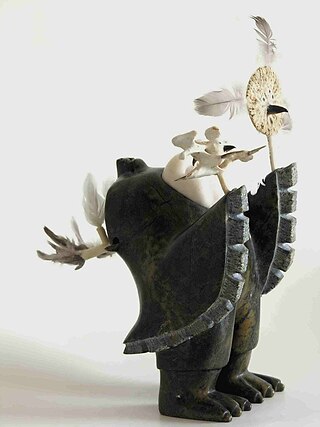
Inuit art, also known as Eskimo art, refers to artwork produced by Inuit, that is, the people of the Arctic previously known as Eskimos, a term that is now often considered offensive. Historically, their preferred medium was walrus ivory, but since the establishment of southern markets for Inuit art in 1945, prints and figurative works carved in relatively soft stone such as soapstone, serpentinite, or argillite have also become popular.

Hohlenstein-Stadel is a cave located in the Hohlenstein cliff at the southern rim of the Lonetal in the Swabian Jura in Germany. While first excavations were started after the second half of the 19th century, the significance of some of the findings was not realized until 1969. The most significant finding was a small ivory statue called the Löwenmensch, which is one of the oldest pieces of figurative art ever found.
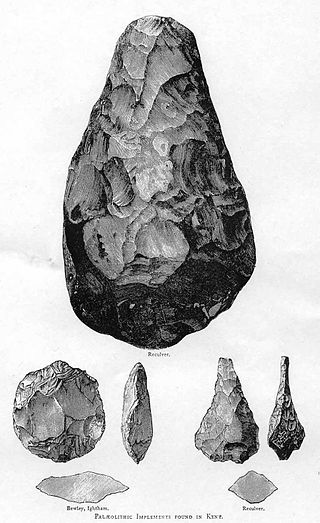
The oldest undisputed examples of figurative art are known from Europe and from Sulawesi, Indonesia, dated about 35,000 years old . Together with religion and other cultural universals of contemporary human societies, the emergence of figurative art is a necessary attribute of full behavioral modernity.

The art of the Upper Paleolithic represents the oldest form of prehistoric art. Figurative art is present in Europe and Southeast Asia, beginning between about 40,000 to 35,000 years ago. Non-figurative cave paintings, consisting of hand stencils and simple geometric shapes, are somewhat older, at least 40,000 years old, and possibly as old as 64,000 years. This latter estimate is due to a controversial 2018 study based on uranium-thorium dating, which would imply Neanderthal authorship and qualify as art of the Middle Paleolithic.
The conservation and restoration of ivory objects is the process of maintaining and preserving objects that are ivory or include ivory material. Conservation and restoration are aimed at preserving the ivory material and physical form along with the objects condition and treatment documentation. Activities dedicated to the preservation of ivory objects include preventing agents of deterioration that specifically connect with ivory as a material, preventative conservation, and treatment of ivory objects. Conservators, curators, collections managers, and other museum personnel are in charge of taking the necessary measurements to ensure that ivory objects are well maintained and will make the decision for any conservation and restoration of the objects.

The Vogelherd Cave is located in the eastern Swabian Jura, south-western Germany. This limestone karst cave came to scientific and public attention after the 1931 discovery of the Upper Palaeolithic Vogelherd figurines, attributed to paleo-humans of the Aurignacian culture. These miniature sculptures made of mammoth ivory rank among the oldest uncontested works of art of mankind. Because of the cultural importance of these sculptures and the cave's testimony to the development of Paleolithic art and culture, in 2017 the site became part of the UNESCO World Heritage Site called Caves and Ice Age Art in the Swabian Jura.
The Salerno Ivories are a collection of Biblical ivory plaques from around the 11th or 12th century that contain elements of Early Christian, Byzantine, and Islamic art as well as influences from Western Romanesque and Anglo-Saxon art. Disputed in number, it is said there are between 38 and 70 plaques that comprise the collection. It is the largest unified set of ivory carvings preserved from the pre-Gothic Middle Ages, and depicts narrative scenes from both the Old and New Testaments. Some researchers believe the Ivories hold political significance and serve as commentary on the Investiture Controversy through their iconographies. The majority of the plaques are housed in the Diocesan Museum of the Cathedral of Salerno, which is where the group's main namesake comes from. It is supposed the ivories originated in either Salerno and Amalfi, which both contain identified ivory workshops, however neither has been definitively linked to the plaques so the city of origin remains unknown. Smaller groups of the plaques and fragments of panels are currently housed in different museum collections in Europe and America, including the Metropolitan Museum of Art in New York, the Louvre in Paris, the Museum of Fine Arts in Budapest, the Hamburg Museum of Art and Trade, and the Sculpture Collection in the Berlin State Museums.

The Morgan Casket is a medieval casket from Southern Italy, probably Norman Sicily. However, it reflects the Islamic style of the Fatimid Caliphate in Egypt, the culturally dominant power in the Western Mediterranean at the time. It is made from carved ivory and bone and is dated to the 11th–12th centuries AD.
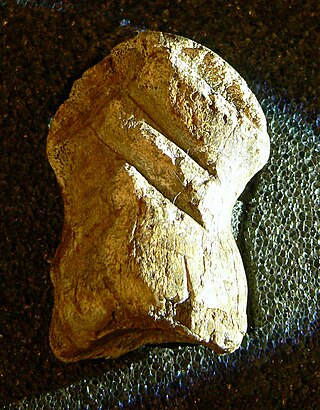
The Giant deer bone of Einhornhöhle is a piece of art made in the Middle Paleolithic period by Neanderthals. Dated to 51,000 years ago, the piece is the oldest piece of art ever found in Europe.

The Embriachi workshop was an important producer of objects in carved ivory and carved bone, set in a framework of inlaid wood, in north Italy from around 1375 to perhaps as late as 1433, apparently moving from Florence to Venice about 1395. They are especially known for what are now called marriage caskets or wedding caskets, hexagonal or oblong caskets about a foot across, with lids that rise up in the centre. Their output of these was probably made for stock rather than individual commissions, and filled a market for gifts for betrothals and weddings. They sold mirrors framed in a similar style, though fewer of these have survived, and religious pieces both small and in a few cases very large.
